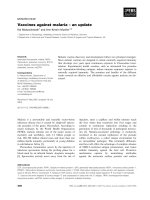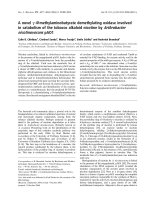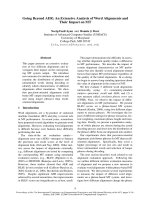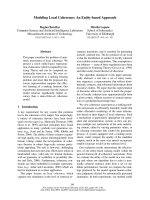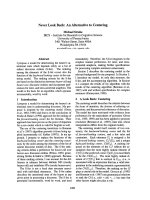báo cáo khoa học: "Speciation burst hypothesis : an explanation for the variation in rates of phenotypic evolution" pps
Bạn đang xem bản rút gọn của tài liệu. Xem và tải ngay bản đầy đủ của tài liệu tại đây (368.2 KB, 7 trang )
Tribune
libre
Speciation
burst
hypothesis :
an
explanation
for
the
variation
in
rates
of
phenotypic
evolution
S.C.
TSAKAS*
J.R. DAVID*
*
Department
of
Genetics,
Agricultural
College
of
Athens,
Athenr,
Greece
**
C.N.R.S.,
Luboratoire
de
Biologie
et
Génétique
évohitives,
F
91190
Gif-sur-Yvette
Summary
Phenotypic
characters
show
remarkable
variability
in
evolutionary
rates
and
at
times
periods
of
seemingly
random
rapid
acceleration.
The
speciation
burst
hypothesis
offers
a
supported
explanation
of
the
variability
of
rates
as
being
primarily
the
result
of
the
organisms
exposure
and
sensitivity
to
ultraviolet
light
and/or
cosmic
rays.
Any
major
disruption
increasing
the
amount
of
exposure
such
as
a
geomagnetic
reversal
would
also
increase
the
evolutionary
rate. An
association
was
found
between
a
period
of
frequent
geomagnetic
reversals
and
rapid
speciation
events
observed
simultaneously
in
2
different
categories
of
organisms,
with
different
habitats,
and
pronounced
difference
in
population
sizes.
Key
words :
Environmental
mutagenesis,
phenotypic
evolution,
geomagnetic
reversals.
Résumé
L’hypothèse
d’une
spéciation
par
bouffées :
une
explication
de la
variabilité
de
la
vitesse
de
l’évolution
phénotypique
Les
caractères
phénotypiques
montrent
une
remarquable
variabilité
dans
leur
vitesse
d’évolution
et
une
accélération
rapide
à
certains
moments.
L’hypothèse
d’une
spéciation
par
bouffées
interprète
cette
variabilité
comme
la
conséquence
d’une
exposition
des
organismes
aux
rayonnements
ultra-violets
et
aux
rayons
cosmiques.
Toute
perturbation
majeure,
comme
par
exemple
un
renversement
du
champ
magnétique
terrestre,
susceptible
d’accroître
l’exposition,
provoquerait
une
accélération
du
taux
d’évolution.
Une
association
entre
une
période
de
changements
fréquents
du
champ
magnétique
et
des
phénomènes
de
spéciation
rapide
est
décrite
dans
2
groupes
d’organismes
qui
diffèrent
à
la
fois
par
leurs
habitats
et
leurs
effectifs.
Mots
clés :
Mutations
dues
à
l’environnement,
évolution
phénotypique,
renversements
du
claamp
géomagnétique.
(1)
S.C.
T
SAKAS
dedicates
this
work
to
Pr
C.B.
K
RIMBAS
in
gratitude
for
25
years
of
collaboration.
I.
Introduction
Phenotypic
characters
show
not
only
a
remarkable
variability
in
evolutionary
rates
ranging
from
very
slow
to
very
fast,
but
in
some
cases
periods
of
stasis
interspersed
with
shorter
periods
of
accelerated
evolution.
Evolutionary
hypotheses
dealing
with
phenotypic
characters
are
needed
to
explain
this
variability.
Such
a
hypothesis
is
speciation
burst
(T
SAKAS
,
1984)
and
in
this
paper
its
explanations
and
potential
for
prediction
will
be
presented.
The
most
important
population
genetics
parameter
for
differentiation-diversifi-
cation-speciation
is
proposed
to
be
mutation.
According
to
this
any
major
disruption
increasing
exposure
such
as
geomagnetic
reversals
would
accelerate
evolution
by
increasing
the
mutation
rate.
During
a
geomagnetic
reversal
which
may
last
from
1,000-
10,000
years
the
biological
material
of
the
earth
is
exposed
to
more
intense
cosmic
radiation
(HA
RRISON
&
P
ROSPERO
,
1974)
and/or
ultraviolet
light
(R
E
m et
al.,
1976).
As
a
consequence,
mutations
with
none,
small,
or
great
phenotypic
effect
will
appear
in
a
relatively
short
period
of
time.
Mutations
with
great
phenotypic
effect
explain
the
absence
of
transitional
forms
(missing
links).
At
the
same
time,
due
to
the
heavy
genetic
load
and/or
environmental
changes,
many
species
become
extinct.
Population
size
does
not
appear
to
play
such
an
important
role
under
these
conditions
(K
IMURA
&
O
HTA
,
1971).
The
population
size
parameter
which
has
been
used
as a
pri-
mary
factor
in
explaining
accelerated
evolution
has
been
called
into
question
by
recent
findings
on
marine
fossils ;
however
these
findings
are
consistent
with
the
speciation
burst
hypothesis.
These
mainly
are :
strong
correlations
suggesting
that
during
the
Phanerozoic
period
a
similar
pattern
of
evolution
had
occurred
simultaneously
on
a
global
scale
(S
E
rxosxi et
al.,
1981) ;
rapid
evolutionary
events
have
been
observed
in
large
populations
containing
millions
of
members
(W
ILLIAMSON
,
1981) ;
sexually
and
asexually
reproducing
taxa
show
a
similar
pattern
of
speciation
(W
ILLIAMSON
,
1981).
II.
Observations
and
explanations
Figure
1
shows
the
concurrence
of
a
period
of
frequent
geomagnetic
reversals
and
accelerated
evolutionary
events
observed
simultaneously
in
2
different
categories
of
organisms,
vertebrate
and
invertebrate,
with
different
habitats,
and
pronounced
difference
in
population
size.
V
RBA
(1980)
reports
a
remarkable
burst
of
speciation
in
Alcelaphini
(antelopes)
(see
figure
2 A)
during
the
period
of
1.5 - 3.0
Myr
which
coincides
with
W
ILLIAMSON
’S
(1981)
data
showing
a
rapid
speciation
event
in
Cenozoic
molluscs
in
the
Turkana
Basin
(see
figure
2
B).
In
addition,
rapid
extinction
also
appears
to
have
occurred
during
this
period,
resulting
in
a
reduction
in
species
duration.
The
majority
of
the
species
becoming
extinct
were
from
the
newly
formed
ones.
This
1.5
Myr
interval
of
time
representing
approximately
1/3
of
the
4
Myr
span
compared
contains
the
greatest
number,
13
out
of
19,
of
geomagnetic
reversals
and
these
occurred
in
two
clusters
(Cox,
1969).
The
speciation
burst
hypothesis
maintains
that
any
factor
affecting
the
amount
or
intensity
of
exposure
to
ultraviolet
light
and/or
cosmic
rays
would
affect
speciation
on
a
continuous
basis
as
well
as
during
geomagnetic
reversals
or
other
disruptions.
The
strong
correlation
observed
between
the
rate
of
chromosomal
evolution
and
rate
of
speciation
in
vertebrates
(BusH et
al.,
1977)
and
in
plants
(L
EVIN
&
W
ILSON
,
1976)
can
be
viewed
from
the
following
perspective.
Ultraviolet
rays
produce
mutations
similar
to
the
spontaneously
arising
ones,
and
ultraviolet
light
and
cosmic
rays
are
known
to
produce
chromosomal
aberrations.
Chromosomal
aberrations
are
a
causal
factor
for
speciation
events
(WHITE,
1980).
This
hypothesis
then
allows
some
preliminary
predictions
which
are
presented
and
followed
by
a
brief
account
of
supporting
data.
A.
Latitude
Speciation
would
be
expected
to
be
faster
closer
to
the
polar
regions
due
to
the
morphology
of
the
geomagnetic
field
which
affords
lower
protection
from
cosmic
rays
in
these
regions
in
comparison
to
the
equator.
HicxEY et
al.
(1983)
found
that
new
forms
of
animals
and
plants
first
appeared
in
the
Arctic
and
migrated
later
to
temperate
climes.
They
report
that
data
from
the
«
Eureka
Sound
Formation
in
the
Canadian
high
Arctic
reveals
profound
difference
between
the
time
of
appearance
of
fossil
land
plants
and
vertebrates
in
the
Arctic
and
mid-northern
latitudes.
Latest
Cretaceous
plant
fossils
in
the
Arctic
predate
mid-latitude
occurrences
by
as
much
as
18
million
years,
while
typical
Eocene
verte-
brate
fossils
appear
some
2
to
4
million
years
early ».
In
research
dealing
with
131
species
of
Benthic
Foraminifera
on
the
Atlantic
Continental
Margin
of
North
America,
B
UZAS
et
al.
(1984)
found
a
shorter
species
duration
and
therefore
faster
evolutionary
rate
in
the
Northern
regions
spanning
from
Cape
Hatteras
to
Newfoundland
in
comparison
to
that
from
Florida
to
Cape
Hatteras.
This
appears
to
be
continuous
for
the
last
50
Myr
period.
B.
Depth
of
aquatic
environment
Due
to
the
protection
afforded
by
water
a
progressively
slower
speciation-
evolutionary
rate
would
be
expected
moving
from
land
to
shallow
water
to
deep
water.
1
ABLONSKI
et
al.
(1983)
report
that
biological
innovations
occur
nearshore
and
expand
outward
across
the
shelf
in
phanerozoic
shelf
communities.
This
can
be
described
as
an
onshore
speciation -
offshore
migration
pattern.
Another
aspect
of
the
extensive
research
on
benthic
Foraminifera
(Buzns et
al.,
1984)
shows
that
evolutionary
rates
are
greater
in
shallower
than
in
deeper
depths
for the
last
60
Myr.
The
combination
of
the
2
factors
already
described
here,
Northern
latitude
and
shallow
depth,
showed
the
greatest
evolutionary
rates,
observed
as
shortest
species-duration
time.
In
figure
2,
six
of
the
seven
newly-derived
gastropods
evolved
from
the
species
Bellamya
unicolor,
Cleopatra
ferruginea,
and
Mellanoides
tuberculata.
A
BELL
(1982)
reports
that
these
species
have
the
following
properties,
a)
they
inhabit
shallow
water,
b)
they
are
capable
of
living
over
a
wide
range
of
pH
and
concentrations
of
dissolved
salts,
c)
they
are
the
most
abundant
of
the
Lake
Turkana
molluscs.
It
is
intriguing
to
note
that
whales
as
opposed
to
the
landliving
mammals
studied
by
Busx et
al.
(1977)
show
markedly
reduced
chromosomal
and
speciation
rates
which
are
found
to
be
at
the
level
of
amphibia
and
reptilia.
C.
Diurnal
vs.
nocturnal
living
habits
Due
to
the
reduced
exposure
to
ultraviolet
light,
it
would
be
expected
that
nocturnal
creatures
would
evolve
at
a
slower
rate
than
diurnal
ones.
This
could
explain
the
significantly
slower
chromosomal
and
speciation
rates
observed
in
bats
as
compared
with
that
of
other
land-living
mammals ;
the
rates
were
close
to
those
estimated
in
amphibia
and
reptilia
(BUSH
et
al.,
1977).
’
D.
Sensitivity
of
the
organism
It
is
predicted
that
the
sensitivity
of
the
organism
to
ultraviolet
light
and/or
cosmic
rays
combined
with
the
level
of
exposure
would
affect
evolutionary
speeds.
Studies
show
that
in
general
mammals
have
the
highest
sensitivity
to
radiation
(as
measured
by
L.D.
50
)
and
this
declines
through
birds,
reptilia
and
amphibia
(C
ASARETT
,
1968).
Figure
3
shows
the
comparative
diversification
of
the
vertebrate
subphyla
mammalia,
aves,
reptilia
and
amphibia
(V
RBA
,
1980)
and
this
reflects
their
respective
levels
of
sensitivity.
III.
Conclusion
The
speciation
burst
hypothesis
offers
a
supported
explanation
for
the
remarkable
variability
in
evolutionary
rates
seen
in
phenotypic
characters
as
being
a
consequence
of
the
exposure
to
and
sensitivity
of
the
organism
to
ultraviolet
light
and/or
cosmic
rays.
The
mitigating
factors
affecting
exposure
such
as
latitude,
aquatic
environment,
living
habits,
and
sensitivity
of
the
organism
give
not
only
insight
into
the
varying
evolutionary
rates
but
also
offer
preliminary
guidelines
for
where
and
when
forms
of
life
would
be
expected
to
evolve
at
slower
or
faster
rates.
For
example,
the
Crossopterygii
(figure
3)
whose
exposure
is
mitigated
by
its
more
protected
environ-
ment
in
the
water
and
its
scaled
outer
structure
does
not
show
any
significant
fluctuation
in
its
evolutionary
rate
for
the
past
300
Myr
but
remains
in
stasis ;
and
the
same
explanations
may
hold
for
another
living
fossil,
the
Limulus
polyphemus,
the
horseshoe
crab,
which
remains
virtually
unchanged
for
the
past
230
Myr
(V
I
ts
A,
1980).
The
intriguing
periods
of
acceleration
in
evolution
can
be
seen
as
the
result
of
increased
exposure
to
ultraviolet
light
and/or
cosmic
rays
due
to
some
major
disruption
such
as
geomagnetic
reversals.
It
has
been
demonstrated
that
pronounced
acceleration
in
speciation
in
Alcelaphini
and
molluscs,
which
are
2
different
categories
of
organism,
with
different
habitats,
and
such
a
pronounced
difference
in
population
sizes,
occurred
simultaneously
with
a
period
of
frequent
geomagnetic
reversals.
Received
August
13,
1985.
Accepted
March
20,
1986.
Acknowledgements
Prs.
M.
K
IMURA
,
A.
CAIN,
D.
W
OODRUFF
,
and
E.
V
RBA
are
thanked
for
their
valuable
comments
and
the
reviewers
for
their
useful
remarks.
References
A
BELL
P.P.,
1982.
Paleoclimates
at
Lake
Turkana,
Kenya,
from
oxygen
isotope
ratios
of
gastropod
shells.
Nature,
297,
321-323.
BUSH
G.L.,
CASE
S.M.,
W
ILSON
A.C.,
P
ATTON
J.L.,
1977.
Rapid
speciation
and
chromosomal
evolution
in
mammals.
Proc.
Nat.
Acad.
Sci.
U.S.,
74,
3942-3946.
BuzAs
M.A.,
C
ULVER
S.J.,
1984.
Species
Duration
and
Evolution :
Benthic
Foraminifera
on
the
Atlantic
Continental
Margin
of
North
America. Science,
225,
829-830.
C
ASARETT
A.P.,
1968.
Acute
radiation
effects
in
whole
animals.
In :
Radiation
Biology,
217-235,
Prentice-Hall,
Inc.,
Englewood
Cliffs,
New
Jersey.
Cox
A.,
1969.
Geomagnetic
Reversals.
Science,
163,
237-245.
H
ARRISON
C.G.A.,
P
ROSPER
O
J.M.,
1974.
Reversals
of
the
earth’s
magnetic
field
and
climatic
changes.
Nature,
250,
563-565.
HicKEY
L.J.,
WEST
R.M.,
DA
wsoN
M.R.,
C
HOI
D.K.,
1983.
Arctic
Terrestrial
Biota :
Paleomagnetic
Evidence
of
Age
Disparity
with
Mid-Northern
Latitudes
During
the
Late
Cretaceous
and
Early
Tertiary.
Science,
221,
1153-1156.
J
ABLONS
KI
D.,
S
EPKOSKI
J.J.
Jr.,
BO
TTJER
D.L.,
S
HEEHAN
P.M.,
1983.
Onshore-Offshore
Patterns
in
the
Evolution
of
Phanerozoic
Shelf
Communities.
Science,
222,
1123-1125.
KI
MURA
M.,
O
HTA
T.,
1971.
Fate
of
a
mutant
gene.
In :
MacARTHUR
R.H.
(ed.),
Theoretical
Aspects
of
Population
Genetics,
3-16,
Princeton
University
Press,
Princeton.
L
EVIN
D.A.,
W
ILSON
A.C.,
1976.
Rates
of
evolution
in
seed
plants :
Net
increase
in
diversity
of
chromosome
numbers
and
species
number
through
time.
Proc.
Nat.
Acad.
Sci.
U.S.,
73,
2086-2090.
R
EID
G.C.,
I
SAKEN
I.S.A.,
H
OLZER
T.E.,
C
RUTZEN
P.J.,
1976.
Influence
of
ancient
solar-proton
events
on
the
evolution
of
life.
Nature,
259,
177-179.
S
EPKOSKI
J.J.
Jr.,
BA
at
BACH
R.K.,
R
AUP
D.M.,
VALENTINE
J.W.,
1981.
Phanerozoic
marine
diversity
and
the
fossil
records.
Nature,
293,
435-437.
T
SAKAS
S.C.,
1984.
Geomagnetic
reversals
as
a
possible
explanation
for
periods
of
punctuated
speciation
on
earth.
Genetics,
107,
suppl.,
s
108.
!VRBA
E.S.,
1980.
Evolution,
Species
and
Fossils :
How
Does
Life
Evolve ?
S.
Africa
J.
of
Sci.,
76,
61-84.
WHITE
M.J.D.,
1980.
Chromosomal
models
of
speciation.
In :
DAVERN
C.I.
(ed.),
Modes
of
Speciation,
1969-226,
W.H.
Freeman
and
Company,
San
Francisco.
W
ILLIAMSON
P.G.,
1981.
Paleontological
documentation
of
speciation
in
Cenozoic
molluscs
from
Turkana
Basin.
Nature,
293,
437-443.

